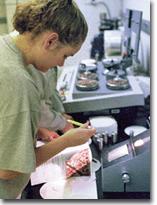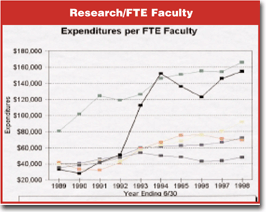As keynote speaker John R. Thompson of Liz Claiborne put it: Technology is no longer simply an enabler. It must drive business improvements and demonstrate appropriate levels of return on investment. Integration is where the power comes in.Thompson, Claiborne’s chief information officer, was addressing over 500 attendees at the annual Computer Integrated Textile Design Association (CItdA) Conference in High Point, N.C.
He shared a candid look at Transformation 2000, a company-wide information technology (IT) initiative that encompasses product development, warehouse management, retail management, decision support, logistics tracking, business planning, EDI and more.
A $2.5-billion company with annual earnings growth of 18.6 percent, Liz has been developing its new IT strategy for the past four years with the realization that customer service and logistics sophistication have replaced brand equity as the differentiators of the 90s. Rejecting ERP systems because they lack a heritage in the apparel industry and are too inflexible, Liz has opted for a best-of-breed computing approach that marries process-specific applications via centralized servers running web-based technology.
At the heart of their pioneering success story is Liz Link, their business-to-business extranet Website and order-tracking system. Liz Link has dramatically reduced the 1,500 to 2,000 calls they receive per day from buyers calling to check on the status of their orders. “This retail management component has enough functionality that, If we needed to, we could run the entire Federated Department Store organization off of this one system,” Thompson said. The system includes data mining, forecasting and trend information that can track and predict sales results that can be analyzed down to individual style components and fiber content.
The system, which supports product data management using Animated Image’s Style Manager software, links offices, mills and factories around the world. It has resulted in a 50-percent reduction in strike-offs and a 50-percent improvement in the design cycle time.
“IT can actually alter your corporate culture, which is something we did not anticipate at first,” Thompson said. “Be sensitive to what IT can mean to your business, and take advantage of it, but dont just go spending blind. IT can also bring you down.”
Studying CAD/CAM Adoption
The integration of CAD/CAM technology into the overall business processes and IT infrastructure has not only brought about sweeping changes in how the industry conducts business, but presented some unique challenges in its implementation.
At the conference, Yan He, assistant professor at Western Illinois University, presented the results of a research study conducted as collaboration between her university and Florida State University. The study was designed to examine the determinants of the adoption, diffusion and infusion of CAD/CAM technology in the American textile and apparel industries. The objectives were to determine the relationship between CAD/CAM adoption and external pressure, the relationship between CAD/CAM adoption and internal pressures, as well as to compare CAD/CAM adoption in companies with different sales volumes.
The results identified external pressure (i.e. reducing throughput time for product assembly, improving product quality and the need to meet retailer standards) and sales volume as being the key determinants of CAD/CAM adoption. External pressure and the size of the company were identified as being the key determinants relating to CAD/CAM diffusion to company employees and projects. The expense of the systems appears to be the major reason against adoption.
The results suggested that CAD/CAM vendors need to put more effort into communicating with their customers and in developing more customized products designed specifically for the small and medium-size companies that represent the majority of the industry.
EAT www.eat-kempen.de
Fiber Arts www.fiberarts.com
Info Design www.idvision.com
JacqCAD International www.jacquad.com
Monarch www.monarchcad.com
Nedgraphics www.nedgraphics.nl
ScotWeave www.scotweave.com
Sophis www.sophis.com
Stli Corp. www.staubli.com
CAD/CAM Integration
Integration was the operative term at this year’s conference, with an increasing number of seminars and vendors offering CAD solutions designed to integrate with an extended range of business processes. These solutions included 3-D virtual reality, sales and marketing systems and computer-aided-manufacturing (CAM) technology for both weave and print technology.CItdA offered its usual fare of seminars and educational programs that highlighted some of the key challenges in the implementation and integration of CAD/CAM technology. Presented by users who work the trenches each day, topics for the seminars included: The Dollars and Sense Side of CAD; Designer to Dobby Loom; The New Role of Technology in Marketing; CAD/CAMs Impact on the Contract Fabric Industry; Exploring Multimedia for Presentations and Instruction; Design Effects in Home Furnishings Design; Business-to-Business Web Commerce; Digital Fabric Printing; a roundtable discussion on Improving the Process from Design to Production; and CAD for Engraving.
The consensus among a panel of freelance designers was that design systems are getting easier to use. Not only is the training easier, but companies are becoming more and more willing to hire and train contract work, as cross-training on multiple systems is relatively easy once a designer understands the basic mechanics of CAD.
Fiber Arts of Roswell, Ga., presented its powerful new CAD driven sales and marketing tool targeted to the home furnishings market. FA 4.0, an in-store sales system, allows the consumer to create her dream room on the fly. A combination database, web application and 3-D rendering technology allows the consumer to visualize a broad range of design options, while supporting an automated sales process for the retailer.
Logikos LLC, New York, presented its 3-D visual merchandising and store planning system called ShopMaker, a sales tool that links an ODBC-compliant visual database of products (illustrations or photography) to a 3-D model of the branded sales floor. The technology allows each fixture and product image to carry its own SKU number, pricing and capacity, and will produce detailed reports that facilitate the buying and store planning processes. Designed for use in both the manufacturing and retail sectors, the Logikos systems are cross-platform and can run on Windows NT, Windows 95 or Macintosh systems. Weave CAD/CAMThis years show offered an expanded presence in weave manufacturing technology and success stories.
Digital Weaving Norway AS, a division of Tronrud Engineering presented their new jacquard weaving system, which creates designs that normally require a loom.The system is able to change the number of shafts, the threading and the weaving techniques instantly.
Staübli Corporation, the 100-year-old Swiss maker of jacquard weaving machines, introduced its LX 3200, a new electronically controlled machine designed specifically for use on high-speed weaving machines and large patterns. Its revolutionary drive concept is based on a single complementary cam drive and is controlled by a high-resolution touch screen display.
AVL of Chico, Calif., showed its new Studio Dobby Loom (SDL), designed for use in universities and design studios. The loom provides the punch of the companys Compu-Dobby® II system in an extremely small and economical package. Available with either 16 or 24 harnesses, its footprint is a mere 30 x 44 inches (112 x 76 cm), and it stands a diminutive 48 inches (122 cm), yet weaving width on the SDL is a full 20 inches (50 cm), which is perfect for sampling and weaving instruction.
JacqCAD International of Millis, Mass., featured its JacqCAD MASTER® textile design software, a Macintosh driven weave application with unparalleled support of industry file formats to drive any weave CAM equipment.
Weave CAD or CAD/CAM solutions were also offered by CADTEX, Sophis, ScotWeave, Monarch, Nedgraphics, EAT, Colour Matters, CIS Graphics and Info Design.
The acquisition of a well-rounded CAD/CAM blanket program for Warren Corporation has been a favorable and successful integration of design and technology.
Rene Koszerowski, senior designer for Warren Corporation, shared her company’s experience in implementing a weave CAD/CAM system. Warren is a high-end, men’s wear worsted suiting fabric manufacturer with design and sales offices in New York City and a mill in Stafford Springs, Conn. They needed a CAD/CAM system that would streamline the blanket designing and production processes (a blanket being defined as a full width warp of 59 inches and usually 48 meters long that is divided into many small warp sections).The company researched CAD/CAM systems for two to three years before they purchased the IN Srl system from Bulciago, Italy. According to Koszerowski, their first season using the system resulted in 85 blankets, which Warren viewed as a great success. In order to achieve this success, they first had to spend four months inputting all of their colors, creating visual yarn structures and connecting them to the yarn ranges in the CAD system.
The design team in New York first had to create the blankets by selecting swatches, assigning them to particular style ranges and choosing colors to create the many color ways desired. The color information was entered in to the system and then sent to the mill design office via e-mail. At the same time, the physical blanket swatches were sent to the mill for analysis. Once the designers at the mill had completed their technical analysis, the information was entered into the system along with the colors that the New York design office had input, e-mailed to the mill and then imported into the blanket program.
The completed blanket was then printed on a laser printer and distributed to the departments involved in making the blankets. These departments include planning, dressing, drawing-in and weaving.Koszerowski claims that her company realized a return on their investment almost immediately. She estimates that they have saved approximately 75 percent of their time in both reduced redundancy of information input and production time by tying their CAD system into their mainframe.As this story and the messages delivered throughout the conference have confirmed, the future of CAD/CAM technology is about leveraging connectivity.
Editors Note: Teri Ross is president of Imagine That! Consulting Group Inc., which offers computer-technology-related products and services to the industry. She is publisher of the award-winning Technology Exchange at www.techexchange.com. She can be reached via e-mail at tekguru@techexchange.com or by phone at (612) 593-0776.
January 1999






